Royal Liverpool Golf Club
England
Links Manager: Craig Gilholm
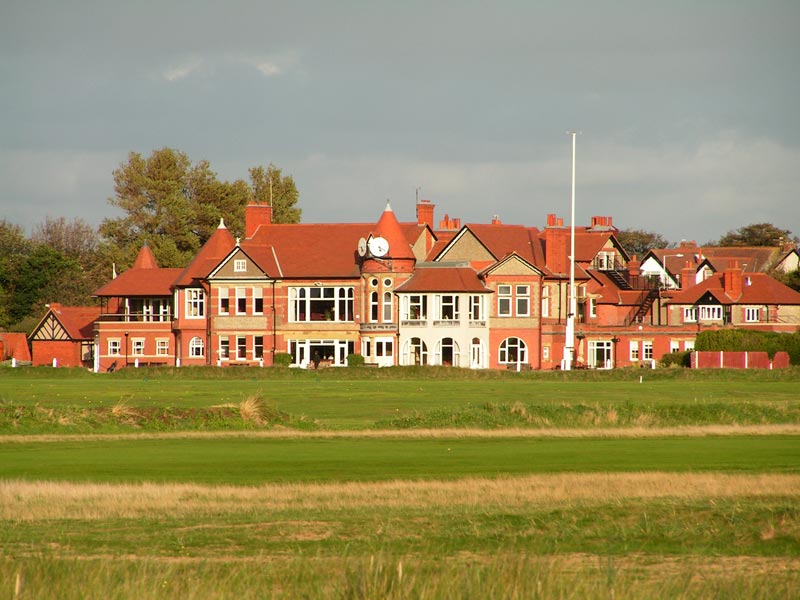
Hoylake moved its clubhouse here just before the turn of the 19th century, where it has since stood guardian for the finest virtues of the game. The flat ground around the clubhouse coupled with…

…the dunes land at the far end of the property led Bernard Darwin to write that the golfer is emphatically on classic golf terrain. This terrian, the ever present wind and the long views at Hoylake cast a spell over all true golfers. The Welsh hills are in the distance.
What if onewere to take away the 16th and 17th holes at The Cypress Point Club? Or the 11th and 12th holes at Augusta National Golf Club? Or perhaps the 11th and 17th holes from The Old Course at St. Andrews?
In lieu of those holes, suppose two solid though not especially noteworthy holes took their place. How would the losses of such holes affect both the perception and the reality of the quality of such courses?
Clearly it would be a terrible blow. However, as witnessed during the play of the 2006 Open Championship, The Royal Liverpool Golf Club has overcome – with apparent ease – such a loss. In doing so, the golfing world was reacquainted with this historic links and its holes of resounding quality.
As successful as the 2006 Open Championship was, two of Hoylake‘s most heralded holes were gone from the mix.In 1930, when Bob Jones won the Open Championship here, the course possessed two of the world’s most feared – and revered – golf holes, the one shot Dowie and the two shot Royal with its long green but a few feet from the boundary line of the property. One definition of a great hole is that it works on the golfer before he plays it and these two holes fit that definition as well as any holes ever have.
In 1910, Darwin, the keenest judge that the world has known regarding what makes for good golf,described The Dowie in The Golf Courses of the British Isles as follows:
Next comes one of the finest short holes in the world, ‘The Dowie‘, which is not only very good, but very unique. There is a narrow triangular green, guarded on the right by some straggling rushes and on the left by an out-of-bounds field and cop; there is likewise a pot-bunker in front. To hit quite straight at this hole is the feat of a hero, for let the ball beever so slightly pulled, and we shall infallibly be left playing our second shot from the tee. Nearly everybody slices at the Dowie out of pure fright, and is left with a tricky little running shot on to the green. The perfect shot starts out of the right, just to show that it has no intention of going out of bounds, and then swings round with a delicious hook, struggles through the little rush hollow, and so home on the green; it is a shot to dream of, but alas! seldom to play.
The shallow area to the right of the green was termed by Herbert Newton Wethered and Tom Simpson in their 1929 book The Architectural Side of Golf to be a ‘gift of the gods.’
The Royal Liverpool Golf Club, with its green across the road from the Royal Hotel, drew equal praise. As the penultimate hole, and with the opportunity to putt out of bounds, the golfer’s frayed nerves were truly tested. Three bunkers guarded the outside of this dogleg to the left but the angle of the green flush against the out of bounds of the road meant that the golfer sought to be as close to the bunkers off the tee as possible.
Alas, both the holes are no more. As the world became a more litigious place around the turn of the twenty-first century, The Royal Liverpool Golf Club was lost as approach shots too readily left the property of The Royal Liverpool Golf Club. Though sad, the Club had no practical choice in the matter and they turned to Donald Steel to bring the 17th green complex some 30 yards away from the road. He did an admirable job with this task, though some members with their keen eye feel that the green might be a bit out of character (e.g. slightly too big and rolling) with the others on the course.
The demise of the Dowie (named after the first Club Captain, J. Muir Dowie) is more complex. Hoylake, famed as Darwin says for its mighty winds and mighty champions, has always lent its course for the contest of the biggest events. It hosted the first Amateur Championship in 1885, the first contest between amateurs from Great Britain & Ireland and the United States in 1921 (which became the Walker Cup), and in 1967, it hosted its tenth Open Championship. By then though,the game was changing with professional golfers carrying more sway than before. The concept of internal out of bounds was a particularly prickly subject with the professionals and it was decided for the 1967 Open that the area left of the cop on the 7th would not be treated as out of bounds. The course identified the popular Roberto De Vicenzoas the Champion Golfer of the Year and the Club began to become comfortable with the notion that the area left of the cop would not be internal out of bounds.
Still, in 1971 when Tony Jacklin and Arnold Palmer were filming a series on the best holes in Britain, two of the eighteen holes were selected from Hoylake:the 1st (of course) and the 7th (equally of course). Holes like the Alps and Hilbre were excluded in favor of Dowie.

Colt’s glorious one shot 11th Alps was no match for Dowie in the eyes of those who produced the 1971 television show on the best holes in Britain.
By the time of the author’s first round here in 1990, the use of internal out of bounds to the left of the 7th was not in practice. {Side note: this did not stop the Morrissetts from deeming it to be out of bounds during their match. The resulting four tee balls were so far right as to only confirm the praise that the hole hadl ong garnered}.
With the out of bounds gone, there was no reason that the hole couldn’t be re-configured, in part to firm up the marshy area that was near the green.Cameron Sinclair oversaw changes to this hole in 1992/1993.
Thus, when the Open returned to Hoylake in 2006, it did so without two of its most famed holes, holes long admired by such keen judges as Bernard Darwin and Tom Simpson. As posed above, very few courses could possibly sacrifice two holes of such distinctionand still present the ideal test to the world’s best.
Yet, that is exactly what Hoylake did. Indeed, in its course set-up and preparation, Hoylake was determined by more than one critic to have been the finest set-up of a non-St. Andrews Open Championship since World War II. Tiger Woods turned in one of the game’s most masterfully controlled performances and in doing so, he highlighted the architectural strength and integrity of the holes at Hoylake.
Who deserves credit for Hoylake of today? From the grounds perspective, the work accomplished by the late Green Keeper Derek Green from 1985 to 2005 deserves special recognition. During the period, various events of great significance were played here, including the 1992 Curtis Cup and the 1995 Amateur. Hoylake hosted the first Amateur in 1885 and the 1995 event marked its 100th playing. The course and its preparation drew rave reviews and acted as springboard for events over the next six years that eventually led the announcement of Hoylake hosting the 2006 Open Championship.
Craig Gilholm succeeded Derek Green in 2005. Coming from Muirfield, Gilholm was well versed in the preparations required for presenting Hoylake in peak form in July, 2006. Everyone who witnessed the 2006 Open marveled at its firm and fast running conditions. Bob Jones remarked much about the keenness of its greens after his 1930 Open victory and Hoylake‘s legacy for the quality of its playing surfaces is once again firmly intact.
As to the design of the holes themselves, Hoylake has evolved and kept pace with changes in the game ever since the course opened in 1869 as nine holes. Laid out by Robert Chambers and George Morris (Old Tom’s brother) over Liverpool Hunt Club’s racecourse, the course was quickly expanded to eighteen in 1871. In fact, through 1876, horse racing was still carried on.
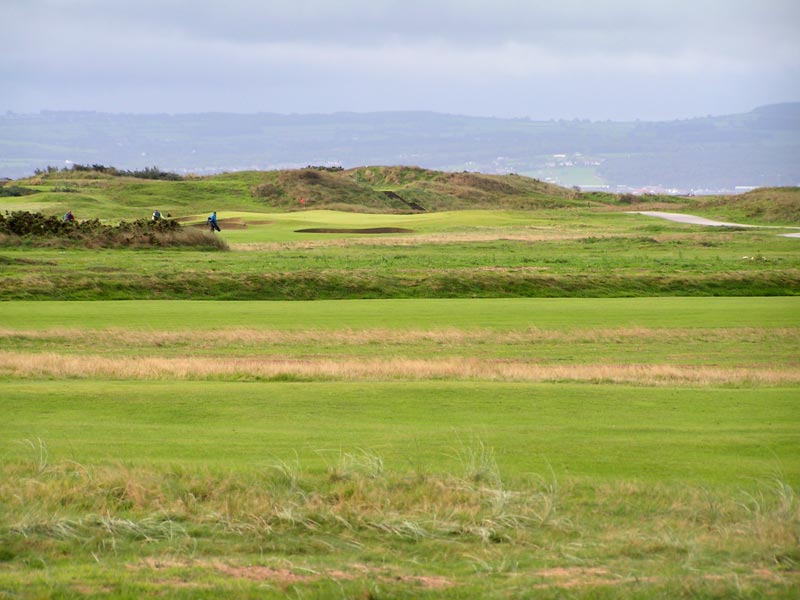
Looking across the 15th and 14th fairways and toward the 3rd green shows what Darwin termed the ‘dear, flat, historic expanse of Hoylake.’ The dunes land that the golfer enjoys from the 8th through the 13th tee is seen in the distance.
Morris and Chambers deserve credit for their work as it was deemed good enough to host four Open Championships and eight Amateur Championship prior to 1924. However, numerous changes have now occurred to their work to the point where little remains. Indeed, the 2nd green is their only green remaining, though their hole played from the direction of the clubhouse. The vast majority of the changes that occurred were often made in preparation for big events. Harry Colt‘s work in 1924,Fred Hawtree’s work in the 1960’s and Donald Steel‘s work in 2000/2001 form the nucleus of the course today, as we see below.
Holes to Note
First hole, 430/425 yards; A poor time to panic, though everyone does, all thanks to a seemingly innocuous three foot cop that divides the right of the hole from the Club’s practice field, which alas is out of bounds. The fact that the cop is relatively low holds two pieces of unwelcome news for the golfer: first, balls that land in bounds can finish out of bounds and secondly, the golfer is afforded absolutely perfect visuals. Like a car wreck, he seems unable to tear his eyes away from the trouble. Wethered and Simpson regarded this as the world’s finest 19th hole (though members at Prestwick Golf Club and Pine Valley Golf Club would like their case heard too). Simpson viewed out of bounds as a crucial element for any great course and he told Henry Longhurst that he considered Hoylake the finest course in England ‘without any doubt.’
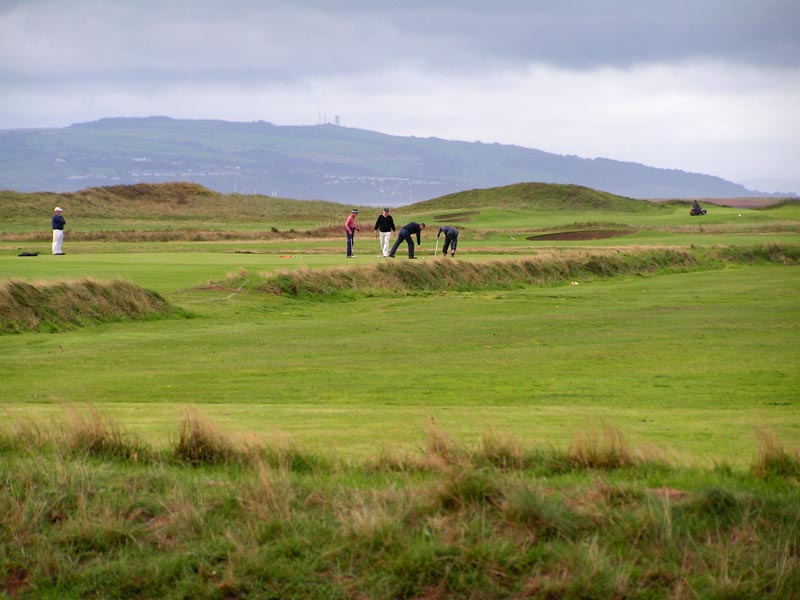
When played into a westerly, this might well be the view for one’s approach: a terrifying shot over the out of bounds practice field to the green on the far side of the cop.
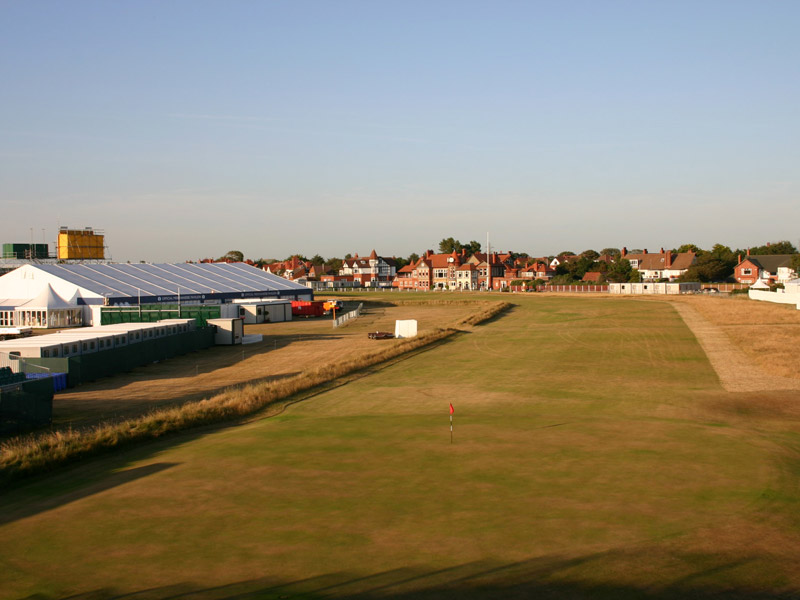
A view back down the 1st fairway during the Open shows how tight the out of bounds is to the fairway and the green (save for the Open Championship, the practice field to the left is just that, devoid of any man-made structures).
Second hole, 370/370 yards; Though the holes in the dunes are more loved, the character of the holes in the flat defines Hoylake – and help it stand utterly unique in the golf world. The nearby Wallasey Golf Club is blessed with bigger dunes and more of them but the relatively lack of merit of its holes in the flats hinder the course’s rise toeven greaterdistinction. Years and years of attention to detail at Hoylake have perfected how this hole plays with two bunkers 275 and 295 yards from the back markers down the left of the fairway matching up perfectly with the green’s left to right axis. The firm playing conditions and the downwind nature of this hole confounded the best during the 2006 Open Championship.
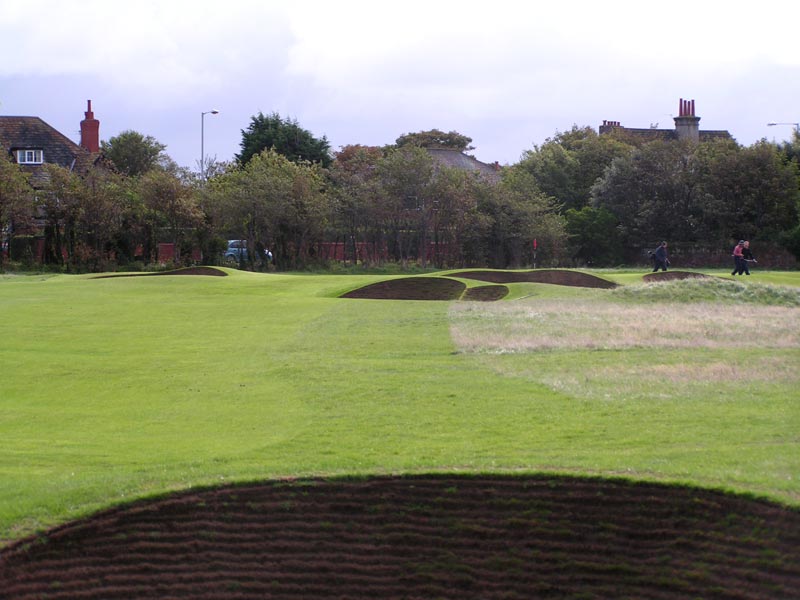
The golfer’s eye is pulled down the right edge of the fairway toward the red flag but the angle of the green insists that the better play is left.
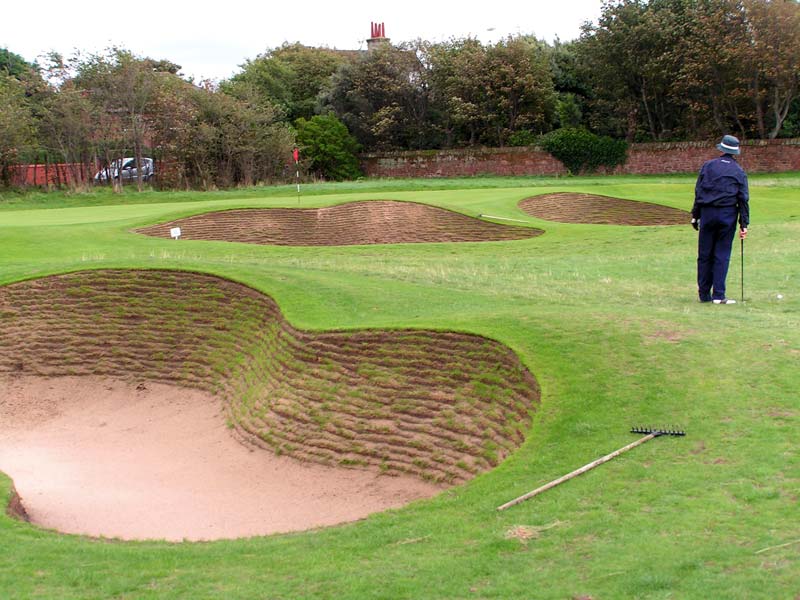
Woefully out of place, the golfer has not only shortsided himself but his recovery shot is now downwind.
Third hole, 530/530 yards, Long; The original hole was much loved by the members and played in a straight direction back along side the14th hole. It too enjoyed an internal out of bounds. Nevertheless, in preparation for the 1967 Open Championship, Fred Hawtree was called in and he gave the hole its great sweep to the left. Donald Steel in turn moved the green back another sixty yards, all being examples of the steps and commitment that Hoylake willingly undertakes for the sake of remaining relevant to stage the game’s finest contests.
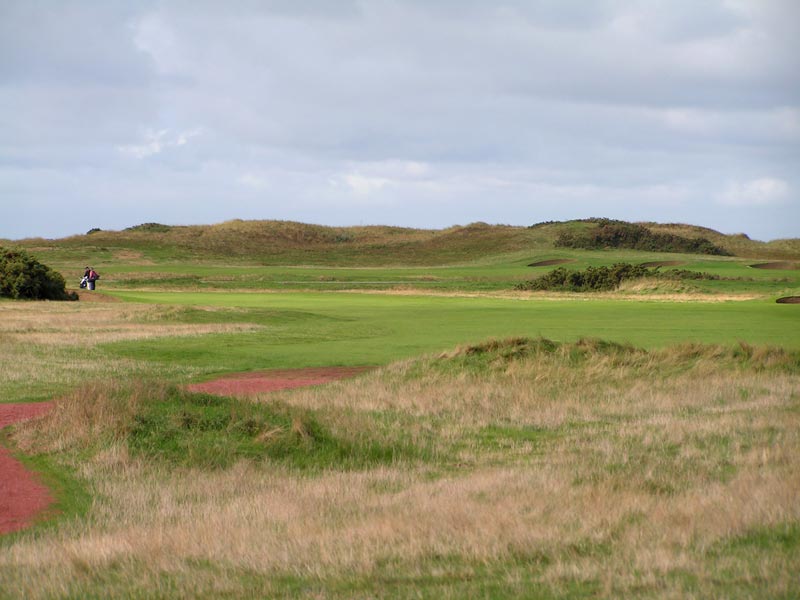
A view from the 3rd tee shows the golfers following the sweep of the hole left with gorse protecting the inside of the dogleg.
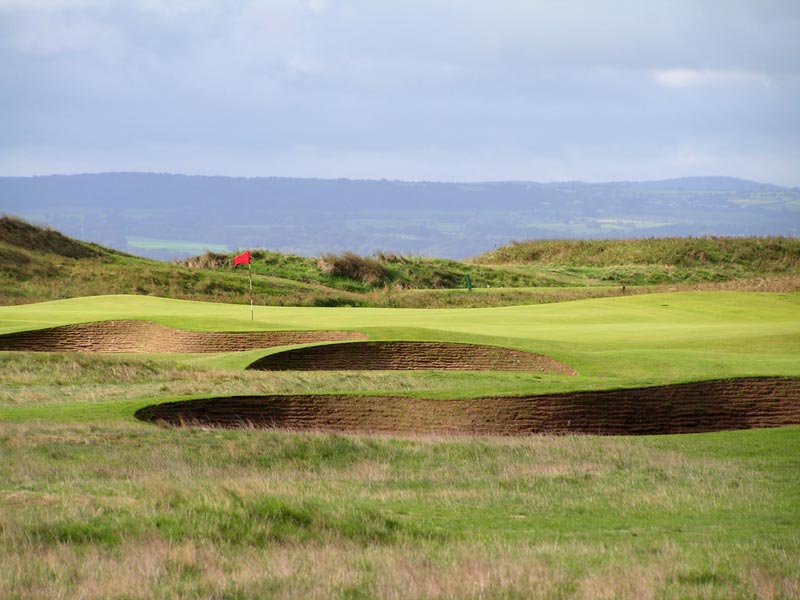
Steel’s beautiful 3rd green fits in with the other greens at Hoylake.
Forth hole, 200/190 yards, New; As the name suggests, this hole was added after World War II and was done by Hawtree at the same time when he brought the3rd hole to the left. There is much to admire with this one shotter as we see below and it is the golfer’s first brush with a dune in his round so far.
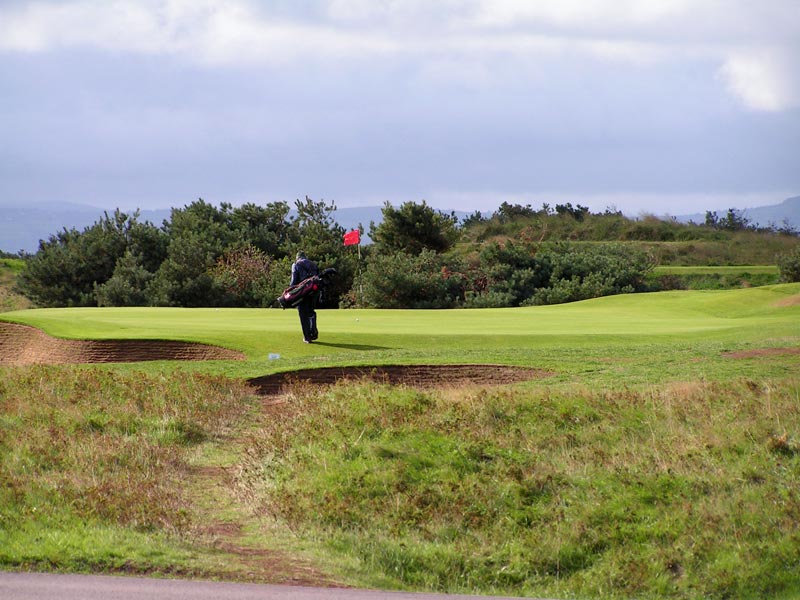
Though some old guard members lament the passing of the old 3rd, no one contends that the old one shot 4th was as good as Fred Hawtree’s 4th.
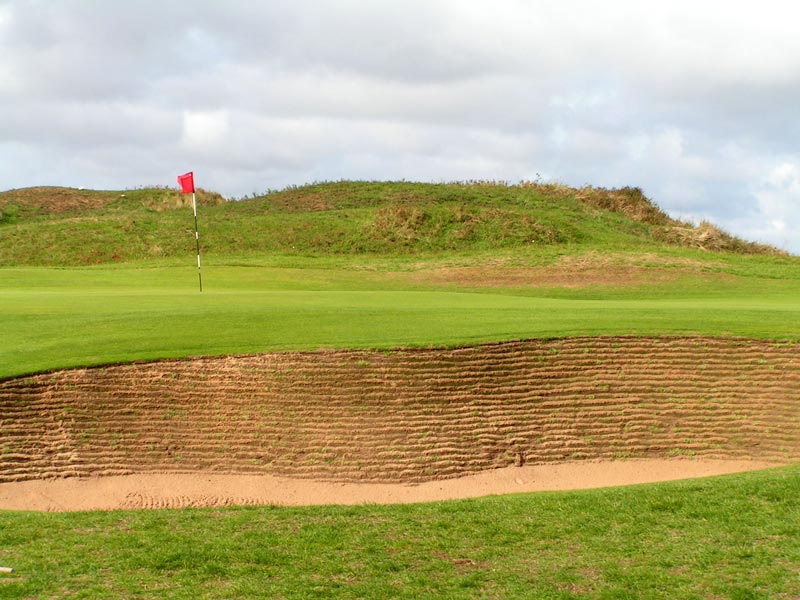
As seen from the left of the green, Hawtree benched his green into a dune and bunkered it front and down the left. The green slopes off the dune, which is to say that it slopes predominately right to left.
Fifth hole, 455/425 yards, Telegraph; Why the flat holes work so well at Hoylake is a must study for all golf course architects. The clear answer is the variety of challenges that, although flat, these holes possess. Be it the cop or the bunkering or the playing angles, there is not a dull one in the bunch. This hole only adds to the variety with its broken ground slashing diagonally across the fairway eighty yards from the green.

The broken ground well in front of the 5th green complicates distance judgment on one’s approach.
Sixth hole, 425/380 yards, Briers; A long time famous hole made by the out of bounds hedge that seemingly walls off the fairway 180 yards from the back marker. With out of bounds left off the tee, the golfer is forgiven for feeling hard done by on days when the hole is played either into the wind or when the wind sweeps right to left across. On the other side of the hedge is one of the wider fairways on the course, as well as one of the best greens as it runs from front to back. Like Royal Melbourne, the tournament committee can make Hoylake a beast by judging the wind in the morning and setting the hole locations accordingly. In this case, the deep front bunkers coupled with the front to back nature of the green make the front hole locations the most tricky.
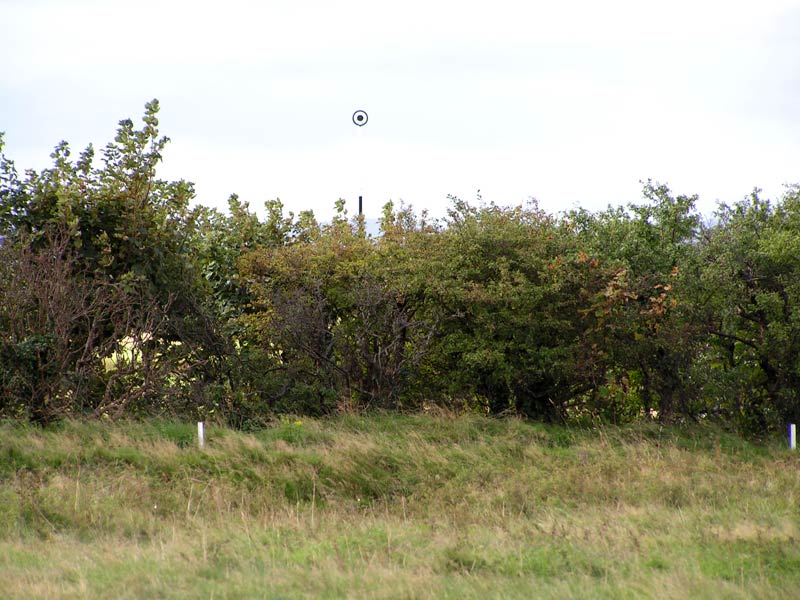
Famous for well over 100 years, the ideal tee ball at the 6th flies over out of bounds.
Royal Liverpool Golf Club
England
Seventh hole, 200/195 yards, Dowie; Cameron Sinclair created a fine hole with dips and swales around the green. However, so long attached is the name Dowie with its predecessor, perhaps the most feared hole in the history of English golf, that the author can’t help but wonder if the hole is changed, so sadly too should its name. Speaking of change, the rules change in 1932 b ythe R&A for hitting out of bounds from one shot to both stroke and distance made the penalty for a miscue left on this hole doubly severe – and ultimately probably led to its downfall 60 years later. One thing is for sure in the author’s mind: if the original Dowie had been played in the 2006 Open Championship, Tiger Woods would have won by even more.
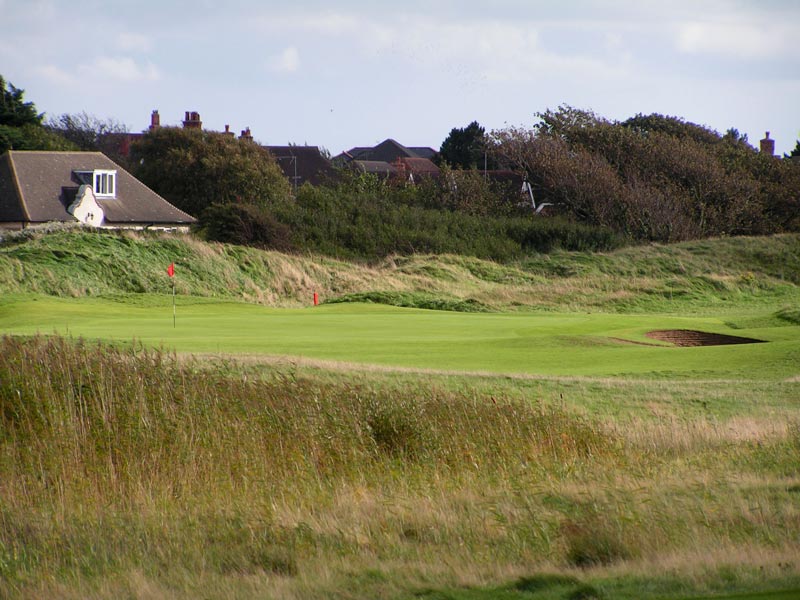
The new 7th is an attractive one shotter but the terror – and the uniqueness – of its predecessor is absent.
Eighth hole, 535/495 yards, Far; One of the fascinating aspects of Hoylake is that the golfer never senses when he is going into the dunes nor when he emerges, so seamless is the transition. Just as Bill Coore did at Friar’s Head, Chambers and Morris transitioned from the flats into the dunes by stretching it across a three shot hole. The first significant dune of the course encroaches into the fairway 180 yards from the green and makes the second shot from tee balls down the right blind. Hoylake’s single most famous bunker is a pit cut into the base of the dune upon which the green rests. Tiger Woods, uncharacteristically, found this famous bunker and took two to get out. Bob Jones avoided it during his final round but still somehow managed to take more shots than he wished, as he describes in Golf is My Game:
The eight hole at Hoylake was of some 480 yards, but I had been consistently either on, or just off, the green in two shoots. This time was no exception. After a good drive my spoon second just missed the left edge of the green and rolled off some ten or fifteen yards down an innocent slope. It lay still in the fairway with absolutely nothing between it and the flag. The events of the next few moments caused such wonderment among the spectators and golfing authorities present. Mr. Darwin said later that a nice old lady with a croquet mallet could have saved me two strokes from this point. Yet I swear that I took seven on that hole in the most reasonable manner possible.
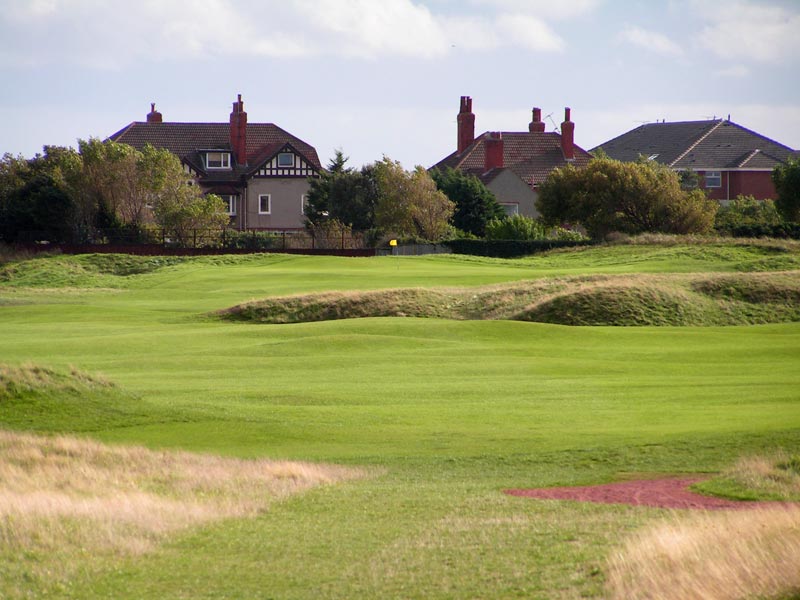
A view down the long 8th where drives down the right frequently yield a blind second shot over the dunes. As at St. Andrews, the ideal line involves hitting down the side with out of bounds.

Colt’s 8th green complex admirably defends the hole against modern technology. The course’s deepest green side bunker is front right and the sloping green is the smallest on a course known for its medium size greens.
Ninth hole, 395/390 yards, Punch Bowl; True to its name, after having played Far, the golfer is at the far end of the property and the views could not be more different than those around the clubhouse. The golfer now finds himself in natural links land. The dunes aren’t massive but rather are perfectly suited to the game of golf. The 9th fairway weaves and bobs through a natural valley. The primary task on the hole is what separates links golf from all other forms: properly flighting an iron from an awkward stance through the breeze.
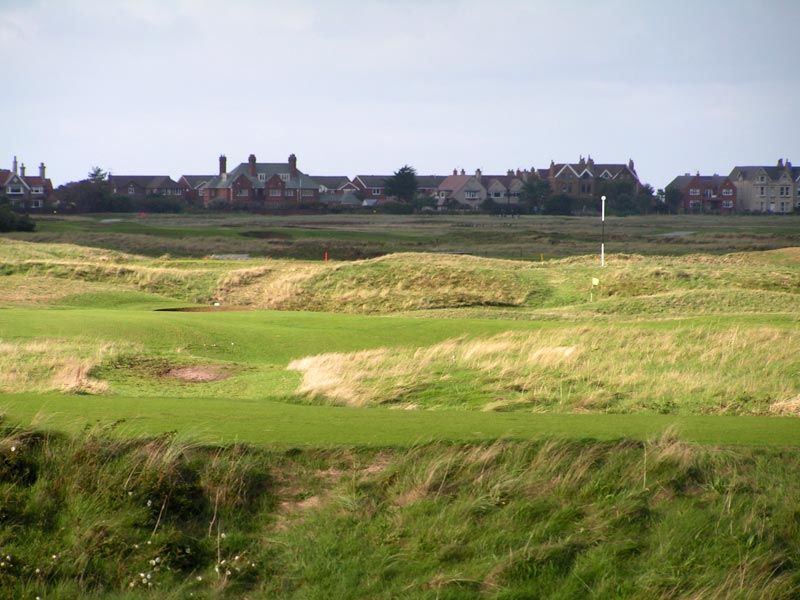
This view from the 9th tee highlights Hoylake’s diversity: six of its holes are in prime dunes land as seen above in the sunlight with the remaining holes on the flat as seen in the shade.
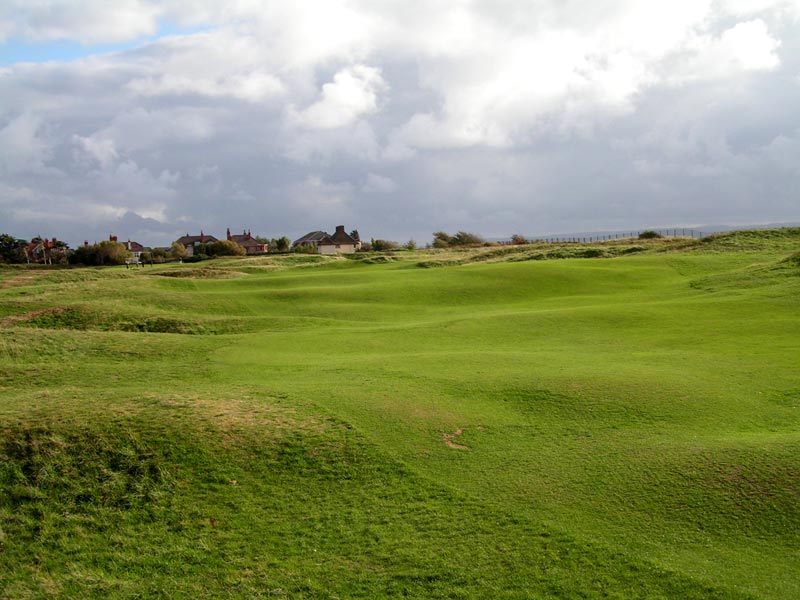
Looking back toward the tee, the 9th hole features the finest crumpled links ground on the course.
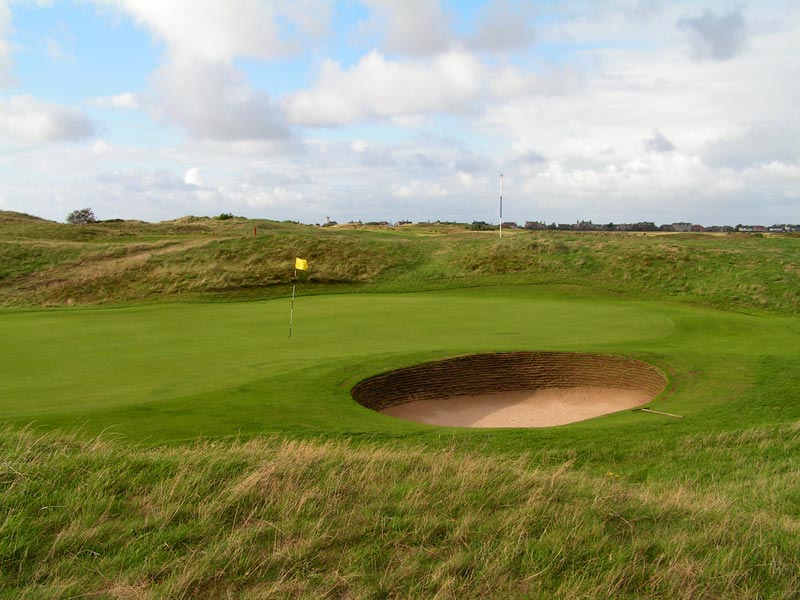
Located in a dell, the front left to back right axis of the 9th green coupled with the hidden front bunker pictured above means that the left side of the fairway is ideal for one’s approach.
Tenth hole, 450/410 yards, Dee; By 1924, Hoylake had hosted X Opens and X Amateurs, and its hosting of these prestige events made it the dominate club in England. Nonetheless, the course at Hoylake has always been a work in progress with a view to challenge the very best and now was no different. This time, Harry Colt was brought in by the Club and the dunes land holes essentially took their present day form. The 8th green was moved up to its crowned position atop a dune from a hollow low and left, the10th and12th greens were moved well left and into the dunes and Colt created the one shot 11th and 13th holes. Colt leveled off a dune to create the 10th green and so good and natural were the green’s defenses that Colt saw no need to build a bunker within 100 yards of it.
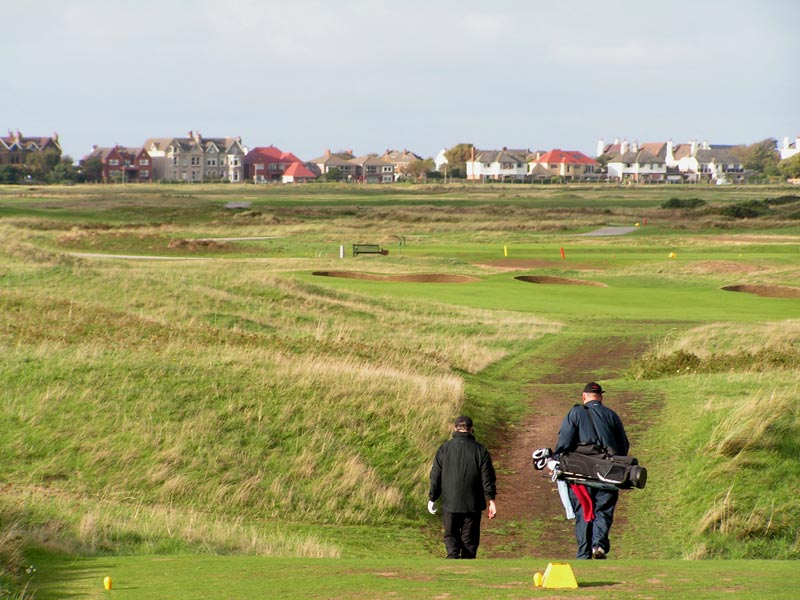
A view from the 10th tee with a series of four bunkers on the outside of the dogleg to the left.
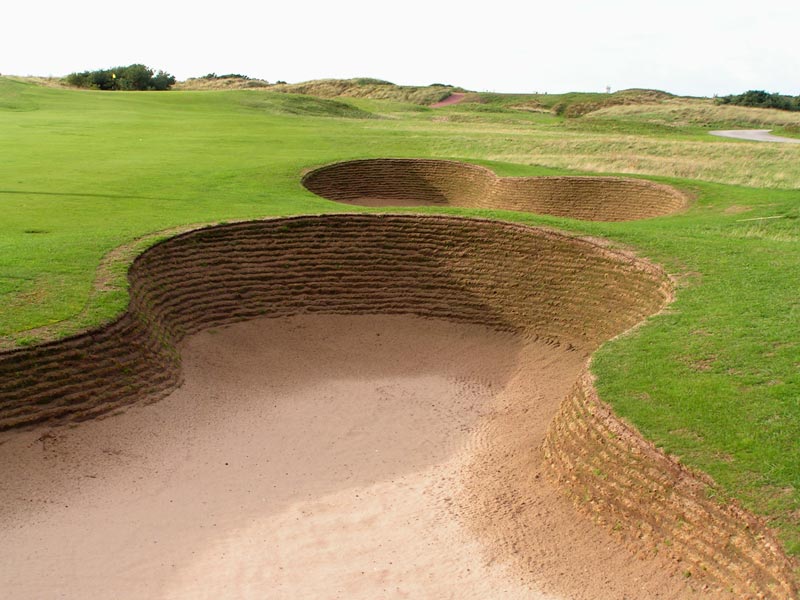
Hoylake’s fairway bunkers are true hazards that command respect and dictate strategy. These are found on the outside of the dogleg 10th, whose left to right sloping fairway helps feed balls toward them.
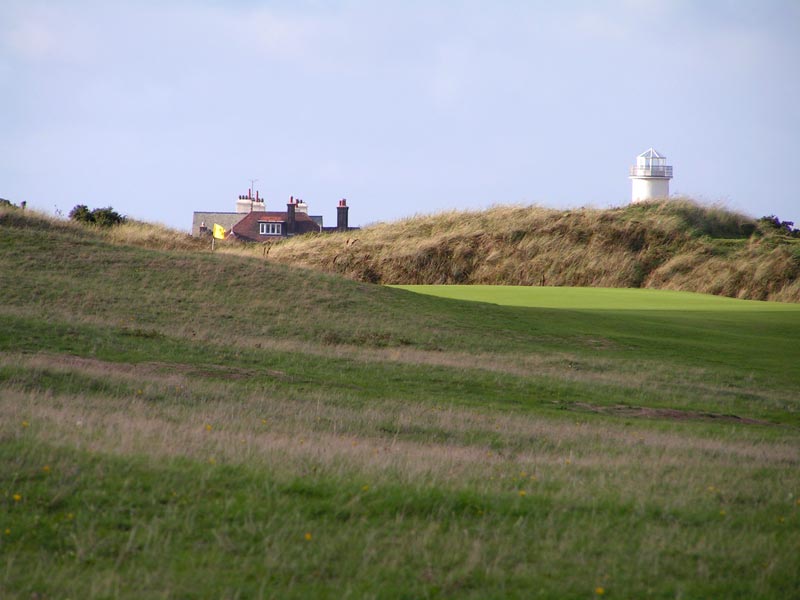
As the golfer rounds the bend of the dune at the 10th, the flag and the green slowly reveal themselves.

From the 10th green to the 11th tee, the golfer soaks in the long views across the Dee estuary. The 9th through the 13th plays in a northerly direction along its shoreline, leaving the golfer fully exposed to the elements.
Eleventh hole, 200/195 yards, Alps; Prior to Colt’s visit, and as captured in Harry Rountree’s 1909 painting, the 11th hole played across the current hole to a green located down and near the forward tees of today’s 12th. As he did at the 8th, 10th, here and the 12th, Colt moved the green to the higher location. Bearing in mind this was the era of hickory golf clubs, such elevated green complexes only added to Hoylake’s overall challenge.

The stretched yellow flag shows a typical wind off the Dee estuary and tells the story: many a tee ball is pushed right…
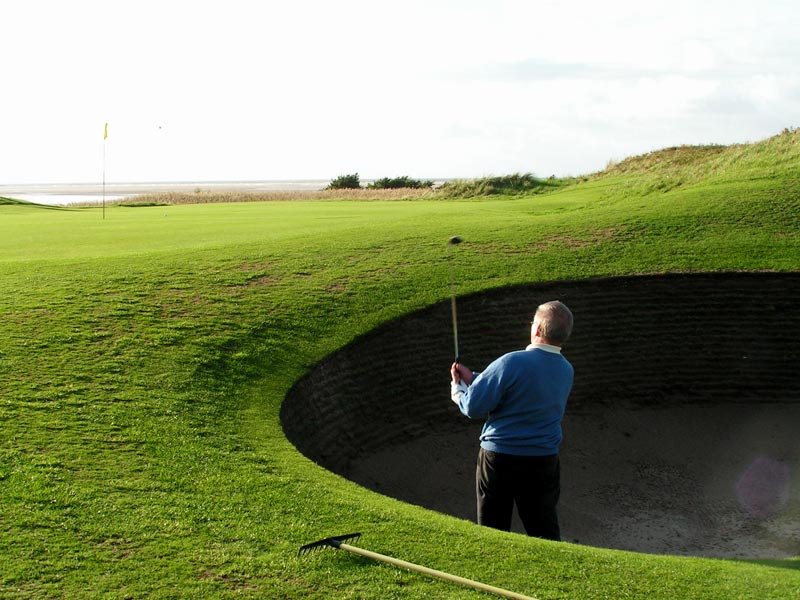
…into the hole’s sole bunker, perfectly placed by Colt.
Twelfth hole, 455/410 yards, Hilbre; Colt moved this green 100 yards to the left and in doing so created what many consider to be the finest hole at Hoylake. Who would dare argue that Colt’s changes weren’t a significant improvement to the dunes land holes? The Hoylake membership, that’s who! There was much gnashing of the teeth when the new holes opened for play, already so loved and revered was the course in 1924.
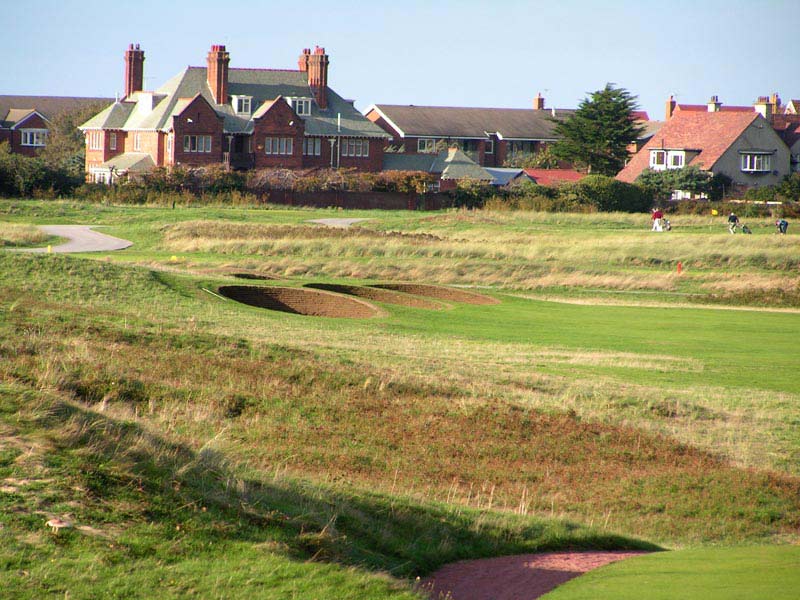
The view from the 12th tee where Colt sharply doglegged the fairway to the left around the three bunkers seen above (the original hole played straight ahead).
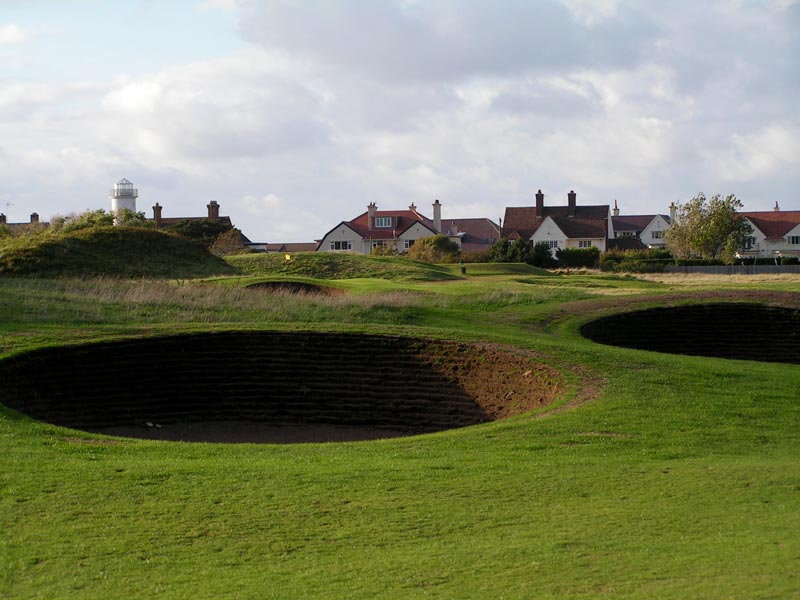
After a perfect drive, a long iron is often still required to reach the none-too-big and partially obscured 12th green.
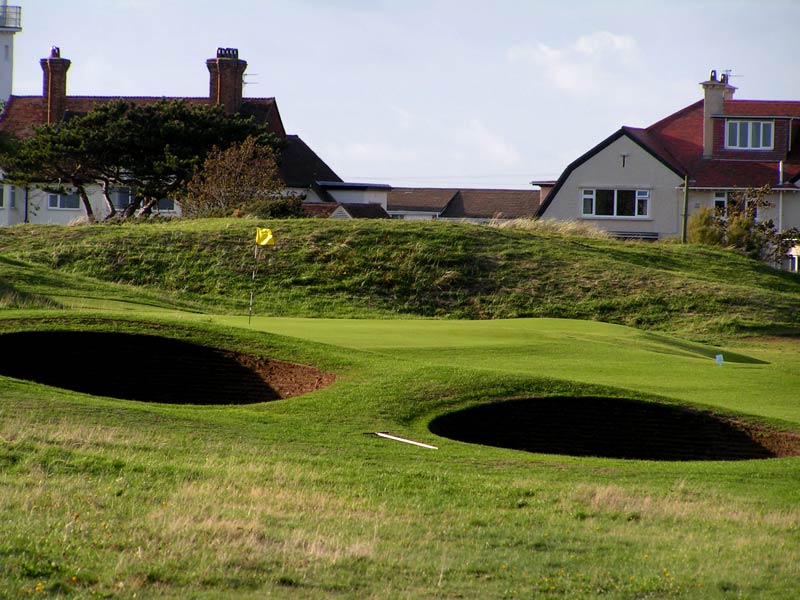
Closer up, the bunkers above are actually 40 yards shy of the 12th green.
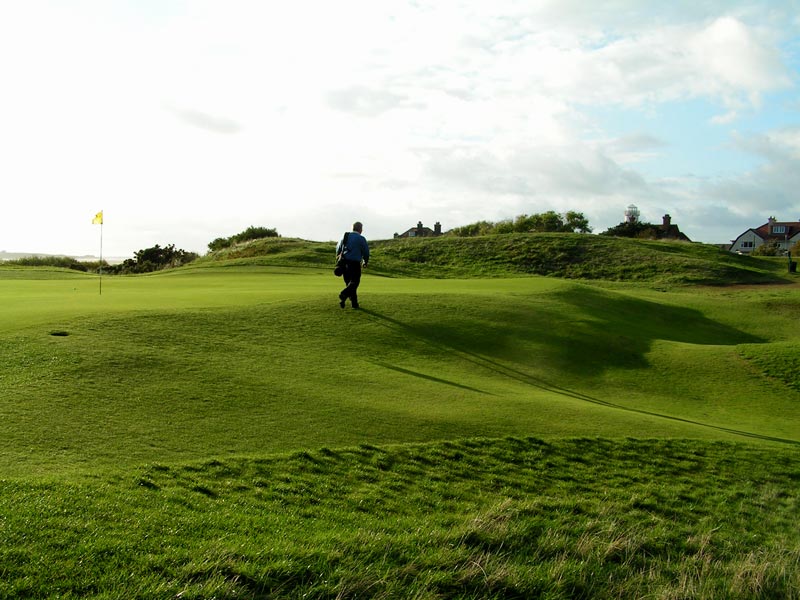
Colt’s superlative bunkerless 12th green complex was made all the better by the R&A when they suggested the mowing pattern above, which creates more varied recovery shots.
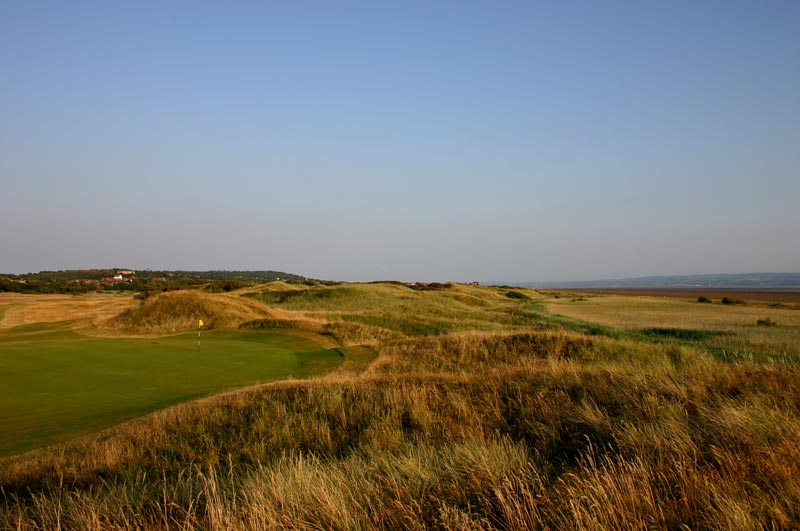
A view back down the 12th shows the superb dunes land that Colt wished to utilize when he moved the 12th green up to its present location.
Royal Liverpool Golf Club
England
Thirteenth hole, 160/155 yards, Rushes; Rountree’s 1909 painting of Hoy lake in Darwin’s Golf Courses of the British Isles shows large homes dotting the landscape north of the 13th hole. Indeed, some of those homes pre-date the turn of the 20th century. Thus, the opportunity to route a few more holes in the dunes was gone and the remaining six holes of the golf course now return to the field. The final one shot hole on the course is an underrated Colt design with no other approach played in the same general direction. Regarding the wind, Patric Dickinson pithily wrote in A Round of Golf Courses in 1951, “Hoylake shares with bicycling the strange fact that whichever way you turn, the wind is plumb against, or at any rate unhelpful, across, or only behind when it is downhill, and you don’t, anyway (e.g. the 13th), want it to be.” A hole of this length (or shorter) should be a requirement for all courses in a windy locale. The wide tee areas give the Club several interesting angles of play toward Colt’s green. From edge to edge the tee boxes are over 50 yards in length and would be out of place anywhere else on the course. Here, tucked in the corner of the property, they work.
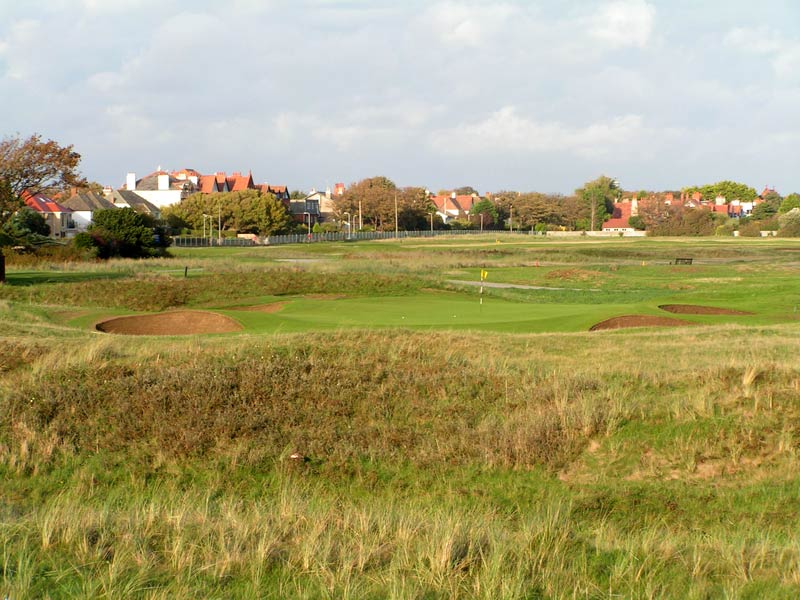
A view from the tee of Colt’s 13th, ringed by five deep bunkers.
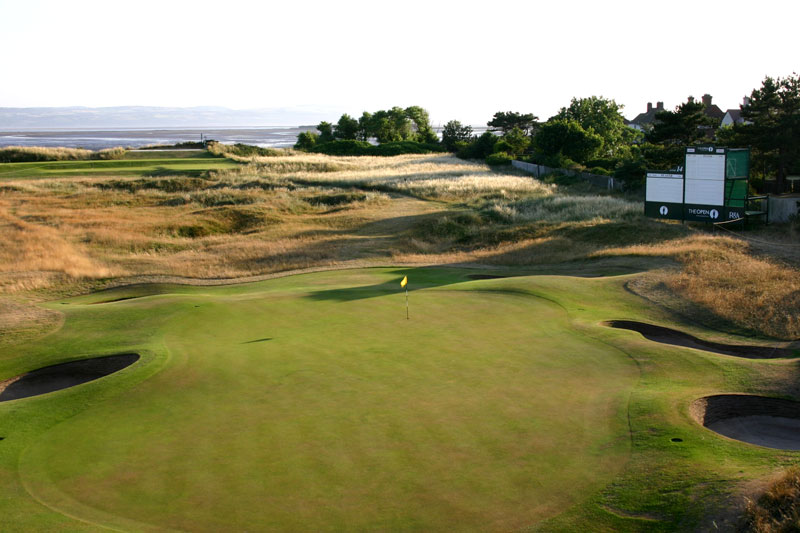
This view of the 13th prior to the 2006 Open Championship captures only half of the teeing area available. Additional tee area is available left out of this photograph, creating more of an angle when played from there.
Fourteenth hole, 555/520 yards, Field; One of the most famous closing stretches in golf now begins with the golfer needing to cover over 2,450 yards in the final five holes. As its name suggests, the golfer is well and truly out of the dunes and Darwin writes, “They may not be much to look at, those last five, but they are horribly good golf.” Though not out of bounds, a cop is used to great effect 100 yards from the green as an elbow that the fairway bends, giving the hole its interesting playing angles. Jack Nicklaus failed to birdie the 14th in the final round of the Open Championship in 1967, which in large part helped Robertode Vicenzohome.
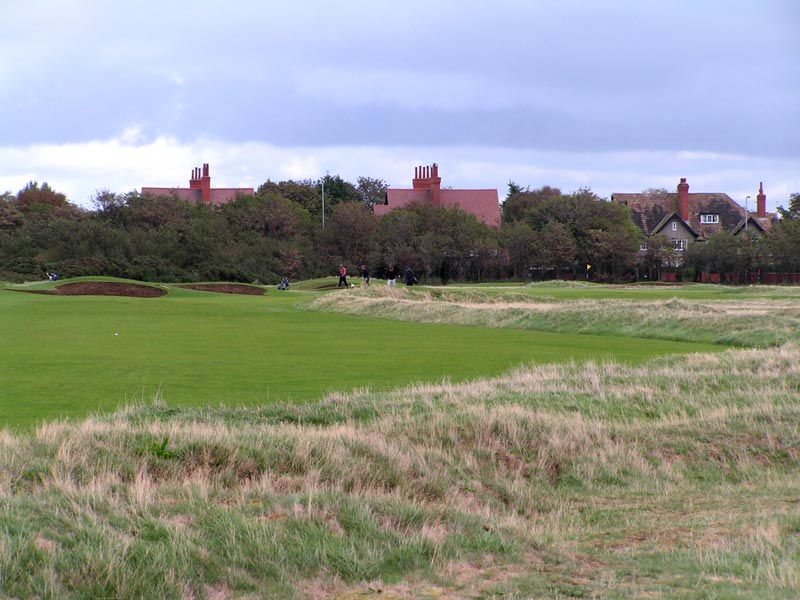
The cop down the 14th does not signify out of bounds but it does create the hole’s interesting playing angles. Cameron Sinclair deserves credit for his work on this cop.
Fifteenth hole, 460/455 yards, Lake; At its highest form, links golf enjoys a sense of expansiveness that only the most open of heathland courses can rival. Out in the flats, this hole certainly has a sense of spaciousness but the play of the hole invariably comes down to its last 70 yards as this hole generally plays into the wind off the water. Six bunkers dot the last fifty yards to the green, which at 40 paces is the second deepest green on the course (behind the overly big17th green that Steel created). Despite its openness, the play of this big hole often hinges on how well the golfer handles the two foot step in the middle of the green that creates two plateaus.

Even from 170 yards away from the 15th green, the shadow on the green tells of the ridge that runs through the its mid-section. Harold Hilton described Hoylakeas ‘a course where the running shot pays’; no finer example of that than here, especially given the ideal playing conditions as fostered by Craig Gilholm and his crew. Also, note the mowing pattern whereas no tall grass hinders a ball from running into the various bunkers.
Sixteenth hole, 560/540 yards, Dun; The only disappointment in Tiger Woods’ performance was that the drama of the final round in the 2006 Open Championship had played out by the time this hole was reached. Other than The Old Course at St. Andrews, every Open course features a long, tough two shotter as its Home hole. Some like the ones at Muirfield and Royal Lytham & St. Anne’s are justly praised but the swing in shots on such holes is generally confined between a birdie and a bogey. This hole promises more death or glory heroics with anything from an eagle to a triple bogey a possibility.
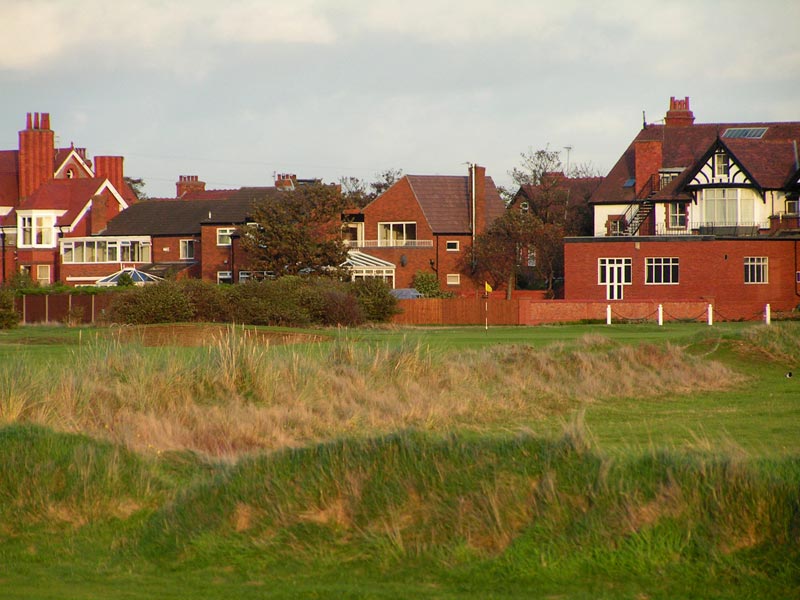
The golfer has driven the ball near the end of the cop and is perfectly positioned to sail a ball over the internal out of bounds and onto the green in two – but only if his nerves hold. No other flat hole in the world offers the chance for the golfer to take such a risk.
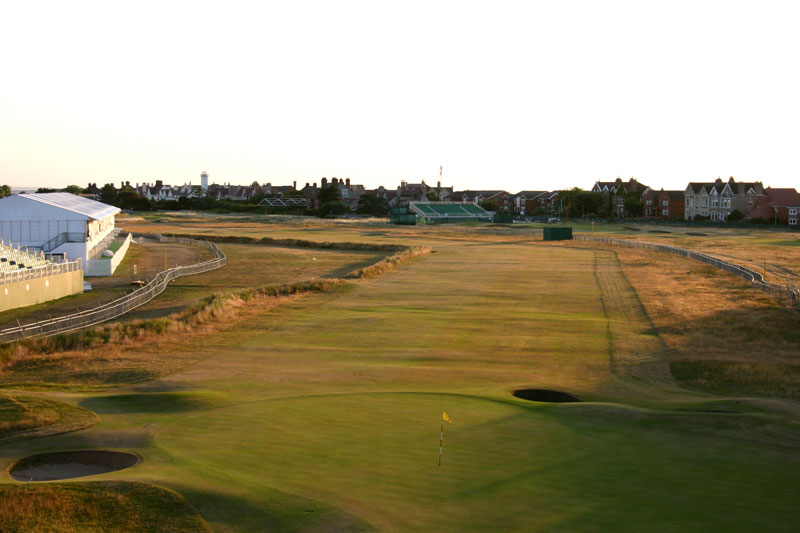
Three spectacular features can be gleamed from this aerial view back down the hole, namely: 1) the excellent playing angle offered for going over the cop and toward the green on one’s second, 2) the horrible playing angle for one’s third the further one’s second shot drifts away from the cop and 3) the color of the turf, indicating ideal playing conditions.
Seventeenth hole, 455/430 yards, Royal; Both the Club and the Royal & Ancient deserve credit for playing this and the next hole as the 1st and 2nd holes during the 2006 Open Championship. The change in sequencing of holes highlighted the Lake and Dun holes as opposed to the Royal and Stand holes, a good thing especially as noted above for the Dun’s ability to produce a heroic finish. The Royal in fact was once the Home hole playing straight toward the (now defunct) Royal Hotel. The Club’s move from the Royal Hotel to the present clubhouse location in the mid 1890s meant this hole became the penultimate one and the then 1st hole became the Home hole. Colt’s work in 1924 included pushing back Morris’ and Chamber’s original green on this hole and angling it against the road. As previously discussed, it was a terror of a hole but with one too many balls leaving the Club property, something had to be done. The task given to Steel was a tough one: create a hole of interest in a flat field. Colt had obviously chosen the route of the green position flush against the Club property but that option was taken away from Steel. Indeed, his only option was to place the green where he did. The rub is that the green he created is far and away the largest one on the course. In addition, though attractively rolling, it is not in keeping with the character of the other long established greens at Hoylake. In some ways, the bigger size of the green makes it a better 1st hole than a 17th.
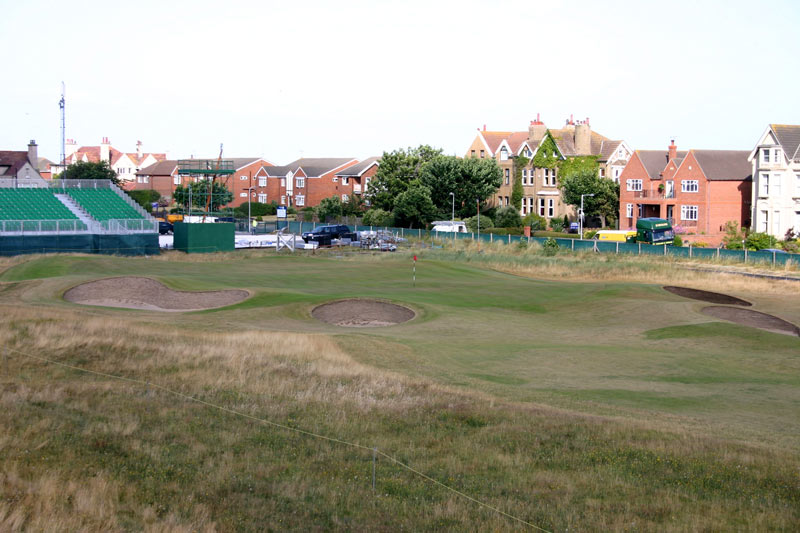
Well away from the road, Steel created a fine green complex. However, the putting surface is bigger with more rolls than the others at Hoylake.
Eighteenth hole, 435/400 yards, Stand; The 18th has seen much change over the past century with the Club continually tweaking it one way or another. Steel’s version was well received and creates some fine hole locations.
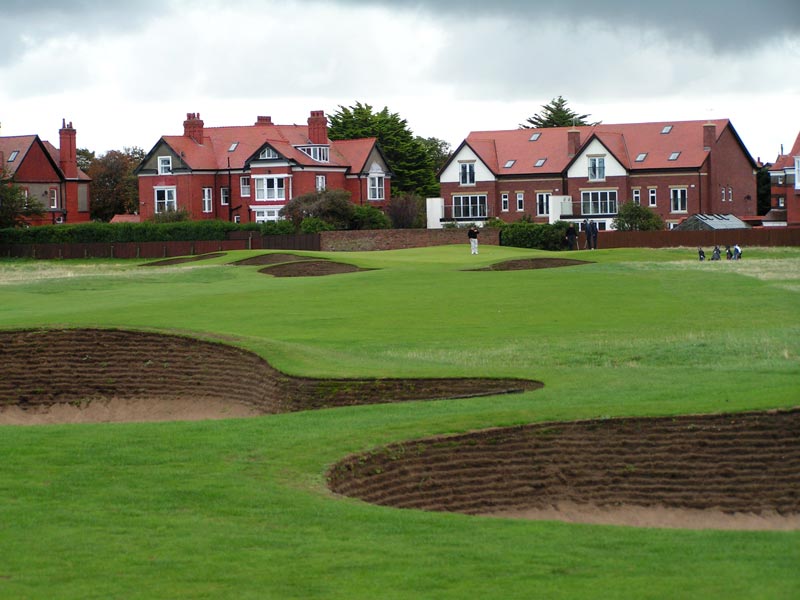
Steel succeeded with his charge in 2000 to tighten the Home hole. The new bunkering scheme led many professionals to hit an iron off the tee in the 2006 Open Championship; such is the respect that Hoylake’s bunkers command.
As usual, Darwin best summarizes Hoylake when he writes, “this place of dull and rather mean appearance is one of the most interesting and difficult courses in the world, and preeminently one which is regarded with affection by all who know it well. Darwin had little patience for those that didn’t understand The Old Course at St. Andrews or here. Regarding such people,Darwin went onto write”He may forthwith be treated with silent contempt, and his opinions may be ignored. He has effectually written himself down as an ass.’ Architect Tom Doak put it kinder when he wrote Hoylake ‘separates the true lovers of links golf from those who only sort of understand it.’
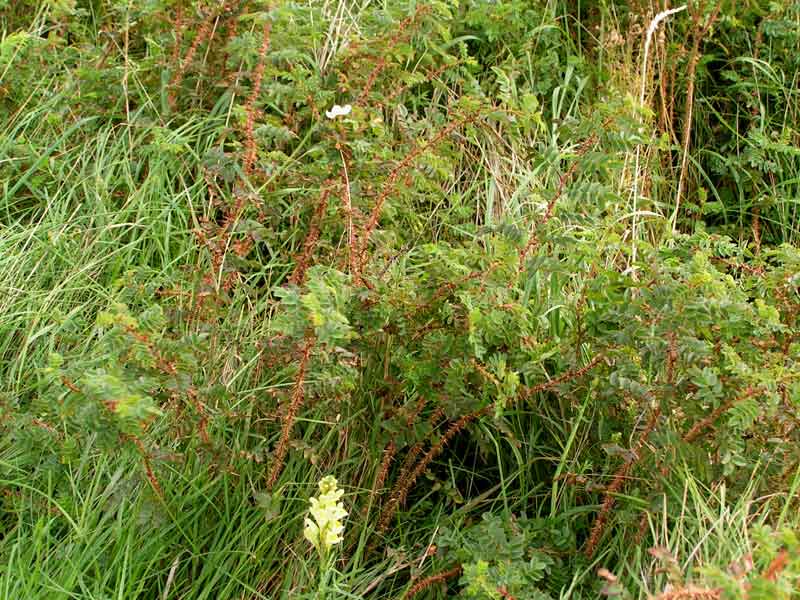
Darwin wrote extensively about the rose bushes at Hoylake. Let Patric Dickinson though have the last word on Hoylake when he wrote that out by the turn ‘is the place, in June, looking for your ball among the roses, to consider the beliefs of your life and what your monument will be.’
The End

